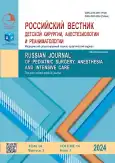Diagnosis and treatment of duodenal fistula in a child: case report
- Authors: Peredereev S.S.1, Svarich V.G.1, Tikhomirov A.I.1, Ti R.A.1, Oleinikova Y.A.1
-
Affiliations:
- Saint-Petersburg State Pediatric Medical University
- Issue: Vol 14, No 3 (2024)
- Pages: 413-420
- Section: Case reports
- URL: https://bakhtiniada.ru/2219-4061/article/view/268216
- DOI: https://doi.org/10.17816/psaic1825
- ID: 268216
Cite item
Full Text
Abstract
In children, duodenal fistulas are often formed against the background of foreign bodies of the gastrointestinal tract (nails and magnetic balls), rarely congenital fistulas. A patient aged 7 years and 9 months was treated for a duodenal fistula in surgical department no. 3 of the clinical hospital of St. Petersburg State Pediatric Medical University. The patient has had repeated vomiting and loose stools since 2023, which were interpreted as an intestinal infection. An overview X-ray of the abdominal organs revealed two X-ray contrast foreign bodies, presumably batteries. In obtaining additional medical history, it was found that the child swallowed the batteries in the presence of his parents on March 3, 2024. In dynamics, after 3 days, the foreign bodies left the patient’s gastrointestinal tract naturally. A long-term, multicomponent examination showed a small-colonic fistula. Further, the EGD with X-ray navigation revealed that the small-colonic fistula was a duodenum-rim fistula. Laparoscopic separation and suturing of the duodenum-rim fistula was performed using a stitching device. After the surgical treatment, clinical improvements were noted: the child’s appetite improved, the patient gained approximately 1 kilogram in weight, the patient’s stool became decorated up to 2–3 times a day, and vomiting did not repeat. Additionally, control ultrasound of the abdominal cavity displayed no pathology. The patient was discharged in satisfactory condition under the supervision of a pediatric surgeon and gastroenterologist at her place of residence. Duodenal fistulas are diagnosed using imaging research methods. The most appropriate method is an X-ray contrast examination of the gastrointestinal tract, which can show the fistula and its extent and localization. Moreover, endoscopic fistulography is an effective diagnostic method. Surgical treatment of duodenal fistulas can be open or laparoscopic. In the current study, the duodenal fistula was probably congenital in nature. However, considering the neurological status and concomitant disease of the child, it can be assumed that the formation of a fistula was caused by ingestion of magnetic foreign bodies.
Full Text
##article.viewOnOriginalSite##About the authors
Sergey S. Peredereev
Saint-Petersburg State Pediatric Medical University
Email: speredereev@yandex.ru
ORCID iD: 0000-0002-9380-8150
SPIN-code: 6046-6407
MD, Cand. Sci. (Medicine)
Russian Federation, 2 Litovskaya st., Saint Petersburg, 194100Vyacheslav G. Svarich
Saint-Petersburg State Pediatric Medical University
Author for correspondence.
Email: svarich61@mail.ru
ORCID iD: 0000-0002-0126-3190
SPIN-code: 7684-9637
MD, Dr. Sci. (Medicine)
Russian Federation, 2 Litovskaya st., Saint Petersburg, 194100Aleksandr I. Tikhomirov
Saint-Petersburg State Pediatric Medical University
Email: tihomirov261@yandex.ru
ORCID iD: 0009-0003-5061-5652
SPIN-code: 5154-3290
MD
Russian Federation, 2 Litovskaya st., Saint Petersburg, 194100Roman A. Ti
Saint-Petersburg State Pediatric Medical University
Email: Sprut009@yandex.ru
ORCID iD: 0000-0003-4116-424X
SPIN-code: 6037-3751
MD
Russian Federation, 2 Litovskaya st., Saint Petersburg, 194100Yulia A. Oleinikova
Saint-Petersburg State Pediatric Medical University
Email: Yuliyaoleynikova32@gmail.com
ORCID iD: 0009-0000-7656-2104
SPIN-code: 2360-9890
MD
Russian Federation, 2 Litovskaya st., Saint Petersburg, 194100References
- Gong J, Wei Y, Gu L, et al. Outcome of surgery for coloduodenal fistula in Crohn’s disease. J Gastrointest Surg. 2016;20(5):976–984 doi: 10.1007/s11605-015-3065-z
- Scharl M, Rogler G. Pathophysiology of fistula formation in Crohn’s disease. World J Gastrointest Pathophysiol. 2014;5(3):205–212 doi: 10.4291/wjgp.v5.i3.205
- Li Z, Peng W, Yao H. Benign duodenocolic fistula: A case report and review of the literature. Front Surg. 2023;9:1049666. doi: 10.3389/fsurg.2022.1049666
- Okadа Y, Yokoyama K, Yano T, et al. A boy with duodenocolic fistula mimicking functional gastrointestinal disorder. Clin J Gastroenterol. 2019;12:6. doi: 10.1007/s12328-019-00977-9
- Becheur H, Piketty C, Bloch F, et al. Endoscopic diagnosis of a duodenocolic fistula due to a non-Hodgkin’s lymphoma in a patient with aids. Endoscopy. 1996;28(6):528–529. doi: 10.1055/s-2007-1005543
- Walradt T, Ryou M, Shah R. A unique management strategy for migrated biliary stent causing duodenal perforation. ACG Case Rep J. 2023;10(10):e01192. doi: 10.14309/crj.0000000000001192
- Kassegne I, Kanassoua KK, Dossouvi T, et al. Duodenocolic fistula by nail ingestion in a child. J Surg Case Rep. 2020;(8):rjaa187. doi: 10.1093/jscr/rjaa187
- Çay A, Ýmamoðlu M, Sarýhan H, et al. Duodenocolic fistula due to safety pin ingestion. Turk J Pediatr. 2004;46(2):186–188.
- Pogorelić Z, Borić M, Markić J, et al. A case of 2-year-old child with entero-enteric fistula following ingestion of 25 magnets. Acta Medica (Hradec Králové). 2016;59(4):140–142. doi: 10.14712/18059694.2017.42
- Vinokurova NV, Tsap NA, Ognev SI, et al. Congenital coloduodenal fistula in a child. Clinical observation. Russian Journal of Pediatric Surgery, Anesthesia and Intensive Care. 2022;12(Special Issue):35. (In Russ.)
- Park MS, Kim WJ, Huh JH, et al. Crohn’s duodeno-colonic fistula preoperatively closed using a detachable endoloop and hemoclips: a case report. Korean J Gastroenterol. 2013;61(2):97–102. doi: 10.4166/kjg.2013.61.2.97
Supplementary files









